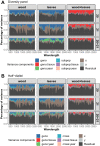Interest of phenomic prediction as an alternative to genomic prediction in grapevine
- PMID: 36064570
- PMCID: PMC9442960
- DOI: 10.1186/s13007-022-00940-9
Interest of phenomic prediction as an alternative to genomic prediction in grapevine
Abstract
Background: Phenomic prediction has been defined as an alternative to genomic prediction by using spectra instead of molecular markers. A reflectance spectrum provides information on the biochemical composition within a tissue, itself being under genetic determinism. Thus, a relationship matrix built from spectra could potentially capture genetic signal. This new methodology has been mainly applied in several annual crop species but little is known so far about its interest in perennial species. Besides, phenomic prediction has only been tested for a restricted set of traits, mainly related to yield or phenology. This study aims at applying phenomic prediction for the first time in grapevine, using spectra collected on two tissues and over two consecutive years, on two populations and for 15 traits, related to berry composition, phenology, morphological and vigour. A major novelty of this study was to collect spectra and phenotypes several years apart from each other. First, we characterized the genetic signal in spectra and under which condition it could be maximized, then phenomic predictive ability was compared to genomic predictive ability.
Results: For the first time, we showed that the similarity between spectra and genomic relationship matrices was stable across tissues or years, but variable across populations, with co-inertia around 0.3 and 0.6 for diversity panel and half-diallel populations, respectively. Applying a mixed model on spectra data increased phenomic predictive ability, while using spectra collected on wood or leaves from one year or another had less impact. Differences between populations were also observed for predictive ability of phenomic prediction, with an average of 0.27 for the diversity panel and 0.35 for the half-diallel. For both populations, a significant positive correlation was found across traits between predictive ability of genomic and phenomic predictions.
Conclusion: NIRS is a new low-cost alternative to genotyping for predicting complex traits in perennial species such as grapevine. Having spectra and phenotypes from different years allowed us to exclude genotype-by-environment interactions and confirms that phenomic prediction can rely only on genetics.
Keywords: Genomic prediction; Grapevine; Phenomic prediction; Phenomics; Plant breeding; Spectroscopy.
© 2022. The Author(s).
Conflict of interest statement
The authors declare that they have no conflict of interest.
Figures






References
-
- Barnes RJ, Dhanoa MS, Lister SJ. Standard normal variate transformation and de-trending of near-infrared diffuse reflectance spectra. Appl Spectrosc. 1989;43(5):772–777. doi: 10.1366/0003702894202201. - DOI
-
- Bernardo R. Prediction of maize single-cross performance using RFLPS and information from related hybrids. Crop Sci. 1994 doi: 10.2135/cropsci1994.0011183X003400010003x. - DOI

